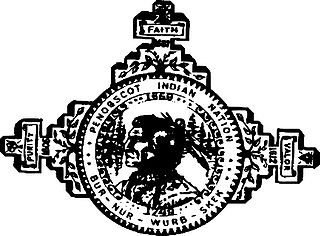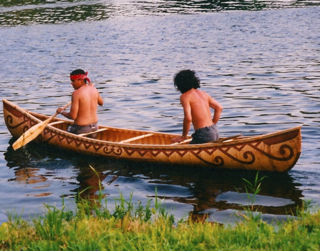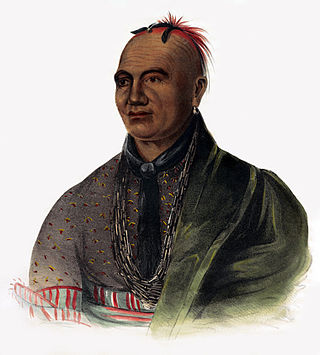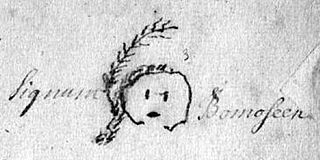
The Abenaki are Indigenous people of the Northeastern Woodlands of Canada and the United States. They are an Algonquian-speaking people and part of the Wabanaki Confederacy. The Eastern Abenaki language was predominantly spoken in Maine, while the Western Abenaki language was spoken in Quebec, Vermont, and New Hampshire.

The Penobscot are an Indigenous people in North America from the Northeastern Woodlands region. They are organized as a federally recognized tribe in Maine and as a First Nations band government in the Atlantic provinces and Quebec.

The Passamaquoddy are a Native American/First Nations people who live in northeastern North America. Their traditional homeland, Peskotomuhkatikuk, straddles the Canadian province of New Brunswick and the U.S. state of Maine in a region called Dawnland. They are one of the constituent nations of the Wabanaki Confederacy.

The Saint John River is a 673-kilometre-long (418 mi) river flowing within the Dawnland region from headwaters in the Notre Dame Mountains near the Maine-Quebec border through western New Brunswick to the northwest shore of the Bay of Fundy. Eastern Canada's longest river, its drainage basin is one of the largest on the east coast at about 55,000 square kilometres (21,000 sq mi). This “River of the Good Wave” and its tributary drainage basin formed the territorial countries of the Wolastoqiyik and Passamaquoddy First Nations prior to European colonization, and it remains a cultural centre of the Wabanaki Confederacy to this day.
The Mi'kmaq language, or Miꞌkmawiꞌsimk, is an Eastern Algonquian language spoken by nearly 11,000 Mi'kmaq in Canada and the United States; the total ethnic Mi'kmaq population is roughly 20,000. The native name of the language is Lnuismk, Miꞌkmawiꞌsimk or Miꞌkmwei. The word Miꞌkmaq is a plural word meaning 'my friends' ; the adjectival form is Miꞌkmaw.

The Algonquians are one of the most populous and widespread North American native language groups. They historically were prominent along the Atlantic Coast and in the interior regions along Saint Lawrence River and around the Great Lakes. This grouping consists of the peoples who speak Algonquian languages.
Philip S. LeSourd is a linguist and an anthropology professor at Indiana University in the United States. He is one of the world's foremost experts on the Maliseet-Passamaquoddy language and the Algonquian language family.
St. Mary's Band or St. Mary's First Nation is one of six Wolastoqiyik or Maliseet Nations on the Saint John River in Canada.

Indigenous peoples of the Northeastern Woodlands include Native American tribes and First Nation bands residing in or originating from a cultural area encompassing the northeastern and Midwest United States and southeastern Canada. It is part of a broader grouping known as the Eastern Woodlands. The Northeastern Woodlands is divided into three major areas: the Coastal, Saint Lawrence Lowlands, and Great Lakes-Riverine zones.

The history of New Brunswick covers the period from the arrival of the Paleo-Indians thousands of years ago to the present day. Prior to European colonization, the lands encompassing present-day New Brunswick were inhabited for millennia by the several First Nations groups, most notably the Maliseet, Mi'kmaq, and the Passamaquoddy.

The Treaty of Portsmouth, signed on July 13, 1713, ended hostilities between Eastern Abenakis, a Native American tribe and First Nation and Algonquian-speaking people, with the British provinces of Massachusetts Bay and New Hampshire. The agreement renewed a treaty of 1693 the natives had made with Governor Sir William Phips, two in a series of attempts to establish peace between the Wabanaki Confederacy and colonists after Queen Anne's War.

The Wabanaki Confederacy is a North American First Nations and Native American confederation of five principal Eastern Algonquian nations: the Abenaki of St. Francis, Mi'kmaq, Maleceet, Passamaquoddy (Peskotomahkati) and Penobscot.
The First Nations of New Brunswick, Canada number more than 16,000, mostly Miꞌkmaq and Maliseet (Wolastoqiyik). Although the Passamaquoddy maintain a land claim at Saint Andrews, New Brunswick and historically occurred in New Brunswick, they have no reserves in the province, and have no official status in Canada.
Tobique First Nation is one of six Wolastoqiyik or Maliseet Nation reserves in New Brunswick, Canada.

Mihku Paul is a First Nations poet, visual artist, storyteller, and activist. She was born into the Maliseet Nation and she is a member of Kingsclear First Nation in New Brunswick, Canada. Mihku Paul currently resides in Portland, Maine where she teaches creative writing at the Maine Women Writers Collection at the University of New England.

The Houlton Band of Maliseet Indians of Maine (HBMI) is a federally recognized tribe of Maliseet, whose land is along the Meduxnekeag River in Maine, United States. They are headquartered in Littleton, Maine, located in Aroostook County.
Madawaska Maliseet First Nation or St. Basile 10 band is one of six Wolastoqiyik or Maliseet Nations on the Saint John River in Canada. The Madawaska Maliseet First Nation (MMFN) territory is in Northern New Brunswick. The MMFN reserve is located 1.6 km east of Edmundston in the north-western region of New Brunswick. The band membership has 350 people. About 114 members of the MMFN live on the St. Basile no. 10 reserve. They are part of the Saint John River Valley Tribal Council. Family names include Bernard, Cimon, Francis, and Wallace.

The Peace and Friendship Treaties were a series of written documents that Britain signed bearing the Authority of Great Britain between 1725 and 1779 with various Mi’kmaq, Wolastoqiyik (Maliseet), Abenaki, Penobscot, and Passamaquoddy peoples living in parts of what are now the Maritimes and Gaspé region in Canada and the northeastern United States. Primarily negotiated to reaffirm the peace after periods of war and to facilitate trade, these treaties remain in effect to this day.

Jeremy Dutcher is a classically-trained Canadian Indigenous tenor, composer, musicologist, performer and activist, who previously lived in Toronto, Ontario and currently lives in Montréal, Québec. He became widely known for his first album Wolastoqiyik Lintuwakonawa, which won the 2018 Polaris Music Prize and the Juno Award for Indigenous Music Album of the Year at the 2019 Juno Awards.

The Maritime Peninsula is a region of eastern North America that extends from the Kennebec River in the U.S. state of Maine northeast to the Maritime provinces of Canada and Quebec's Gaspé Peninsula. It is bounded by the Gulf of Saint Lawrence to the north and the Gulf of Maine to the south.



















